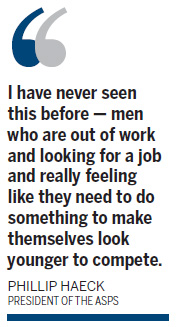Science and Health
More US men getting plastic surgery: Study
By Kerry Sheridan (China Daily)
Updated: 2011-03-22 08:20
 |
Large Medium Small |
WASHINGTON - Facelifts are surging in popularity among US men as the country digs out of recession and the older set aims to compete with a younger, tech-savvy generation, a survey showed on Monday.
| ||||
Those figures still lag behind the all-time peak in plastic surgery reached in 2007 just before the financial downturn.
But they do point to a new trend among men age 40-54, who had the majority of work done, for 48 percent of the total procedures in the entire year, followed by people age 55 and over.
"More than ever, this generation of men are pretty nervous about the younger guys they are competing with," said Phillip Haeck, president of the ASPS.
|
 |
"I have never seen this before - men who are out of work and looking for a job and really feeling like they need to do something to make themselves look younger to compete," he said.
The most popular surgery for men was nose reshaping, or rhinoplasty, with 63,585 such operations performed in 2010, said the ASPS. Next was eyelid surgery (31,476), followed by liposuction (23,899).
Breast reduction (18,280) and hair transplants (13,217) ranked fourth and fifth.
Haeck, who is based in Seattle, Washington, said he also sees lots of men who are gainfully employed at major Internet firms but fearful of losing their edge in a youth-driven field.
"A lot of my business is with people in the tech industry, from Microsoft to Google and everything else that is located here," he said.
"When you are the only 50-year-old working in a cubicle-sea full of 20-somethings who are tech-savvy and you had to learn it all ... I see some guys with almost a chip on their shoulder about being the old guy in the office."
Other trends that boost the male desire for a nip and a tuck include the trend toward more casual dress, Haeck said.
"If you have a pudgy figure, you used to me able to cover it with a sport coat or a suit," Haeck said.
"With this fashion trend toward business-casual, you have got to look nice in a dress shirt that is tucked in at the belt.
"Guys come in and say 'I have got to look good in these shirts and I go to the gym all the time but I can't lose this muffin top. These love handles drive me crazy.'"
The open-necked dress shirt is also a danger zone for some older men, he said.
"They have a neck waddle or a neck gobbler. Their face still looks somewhat youthful, maybe a little rugged, but they hate this wad of skin that hangs from their chin down to their chest," he said.
In addition to the 14 percent rise in facelifts among men, who had 10,902 such procedures last year, some other unusual procedures saw big increases, such as a 62 percent rise in calf augmentation and an 11 percent rise in ear surgery.
"If you're a male and you have short hair and your ears really stick out, that (surgery) is getting them to be more aesthetically pleasing, almost like pinning back your ears," explained ASPS spokeswoman Lisa Arledge Powell.
Male procedures still hardly made a dent in the overall pool, with women making up 91 percent of all cosmetic surgery procedures: men had 1.1 million cosmetic procedures, while women had 11.5 million last year.
The most popular cosmetic surgery procedure among women was breast augmentation, with 296,203 procedures in 2010.
Geographically, the youth-clinging desires of an aging population were most prominent in the western part of the US, including image-conscious California.
Agence France-Presse
| 分享按钮 |



